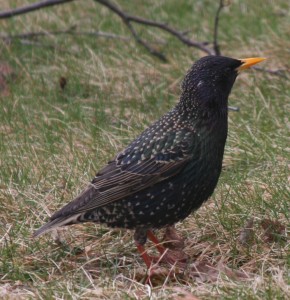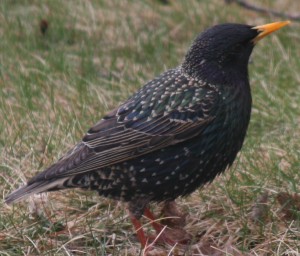Common Starling
General:
The Common Starling, European Starling, is native to most of temperate Europe and western Asia. It was introduced into the New York in 1890 when only 100 birds were released. (1) Since then they have spread throughout the US and Canada. Large flocks of Starlings (easily made up of thousands of birds) can be seen in farm areas in upstate NY. This has proven to be both beneficial and detrimental at the same time. They do eat many crop damaging insects yet they also eat grain seeds and have replaced native species. Frankly, I believe this a classic example of the unintended consequence of introducing an “invasive species”.
 The breeding season begins in early spring and summer. Males choose the nest site and use it to attract females. (2) I have had numerous issues with Starlings becoming stuck in vent grates and have friends that had them entering the house via the fireplace. Starlings also occasionally nest in burrows and cliffs. The female lays 3 to 6 light blue – green/white eggs. The incubation period is approximately 12 days. The chicks are helpless when hatched. They fledge in approximately another 21 days. Pairs may have three broods per breeding season.
The breeding season begins in early spring and summer. Males choose the nest site and use it to attract females. (2) I have had numerous issues with Starlings becoming stuck in vent grates and have friends that had them entering the house via the fireplace. Starlings also occasionally nest in burrows and cliffs. The female lays 3 to 6 light blue – green/white eggs. The incubation period is approximately 12 days. The chicks are helpless when hatched. They fledge in approximately another 21 days. Pairs may have three broods per breeding season.
The Common Starling is a great vocal mimic: individuals can learn the calls of up to 20 different species. Their normal calls are rather raspy calls with no real rhythm.
As a note – in NY there is no closed hunting season on Starlings (at least now).
 Identification: Starlings are chunky and blackbird-sized they are 8”–9” long with a wingspan of approximately 13”-16”. They weigh between 2–4 oz. The bill is narrow conical with a sharp tip. In flight their wings are short and pointed as are their tails. At a distance, starlings look black. In summer they are purplish-green iridescent with yellow beaks; in fresh winter plumage they are brown, covered in white spots. Their legs are stout and as can be seen are pink/red.
Identification: Starlings are chunky and blackbird-sized they are 8”–9” long with a wingspan of approximately 13”-16”. They weigh between 2–4 oz. The bill is narrow conical with a sharp tip. In flight their wings are short and pointed as are their tails. At a distance, starlings look black. In summer they are purplish-green iridescent with yellow beaks; in fresh winter plumage they are brown, covered in white spots. Their legs are stout and as can be seen are pink/red.
Juveniles are grey-brown, and by their first winter resemble adults though often retain some brown juvenile feathering especially on the head in the early part of the winter.
Habitat:
European Starlings prefer urban or suburban areas. They also commonly reside in grassy areas such as farmland, grazing pastures, open forests and woodlands.
Territory:
Starling range from Alaska, through much of Canada, all the contiguous US.
Migration:
Starlings do not engage in any significant migration.
Food:
Starlings are omnivorous but they eat mostly insects and other invertebrates such as grasshoppers, beetles, flies, caterpillars, snails, earthworms, millipedes, and spiders. They also eat fruits and grains and will frequent bird feeders.
(1) The Audubon Society Field Guide to North American Birds